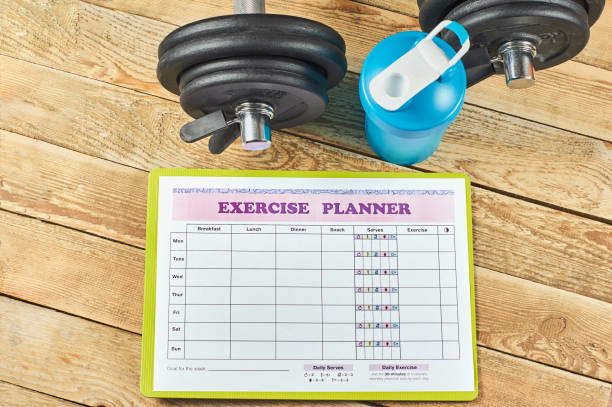Understanding Bro Split Workouts
With ample rest time and easier organization, Bro Split Workouts are a great way to help you reach your fitness goals. Keep reading to learn more about the benefits and limitations of this popular workout routine!
Definition and Common Training Methods
A bro split workout is a type of resistance training program used by bodybuilders, weightlifters, and other athletes to maximize muscle growth in specific areas. The routine consists of a five-day training program, with each day designated to target one or two muscular groups.
This setup allows for ample recovery time so as to optimize muscle building in the specified areas. Bro splits are based on hypertrophy principles that focus on proper form and higher rep ranges to elicit maximal size gains from isolated exercises such as curls, presses, and extensions.
The result is an improved strength or aesthetic look that often allows for improved performance or increased confidence from an enhanced physique due to the effective isolation possible through these workouts.
Are Bro Splits Effective? Debunking Myths
Bro splits are a popular exercise routine that involves training different muscle groups on specific days. This method allows individuals to focus on key areas, with a common belief being that it is the most effective approach to growing muscles quickly.
Research shows, however, that there is generally no compelling evidence in support of bro splits; rather, training each body part twice per week can be more beneficial for consistent gains in lean body mass and overall hypertrophy among natural lifters when compared to those following a once-per-week split.
Although this method does focus on isolating major muscle groups, the volume should not be taken too far — otherwise, progress may suffer due to overtraining or injury risk. Training three times a week gives your body enough time to rest between workouts, allowing muscles adequate recovery time while still providing sufficient stimulus for growth and strength development throughout the entire session cycle.
The Structure and Benefits of Bro Split Workouts
A bro split is designed to separately train muscle groups each day, providing ample recovery time and allowing for easy organization of the training plan.
Upper Body Heavy: The Emphasis on Upper Body in Bro Splits

When it comes to bodybuilding and hypertrophy training programs, a bro split workout routine is often utilized for its efficiency and simplicity. These intense workouts capitalize on the core principles of muscle growth, dedicating an entire day to one or two major muscle groups.
Specifically focusing on upper-body exercises, this type of program emphasizes the use of high-volume strength training with the aim of blasting your targeted muscles through intense sets and reps.
Multiple research studies have shown that performing full-body compound exercises can lead to improved muscle activation; however, there are certain key benefits associated with bro splits which make them ideal for those looking to focus on building their upper body specifically.
A typical bro split involves dedicating each day of the week to one or two main muscles in order to train them enough while not overtraining them due to the increased risk for injury and fatigue that come from exercising too many parts in a single session.
Ample Recovery Time: How Bro Splits Promote Rest
One of the main advantages of bro split workout routines is that they facilitate maximal recovery and muscle growth. Bro splits involve training each major muscle group once a week, rather than all at once, as with other approaches such as full body routine or push/pull/legs (PPL).
This provides ample time for muscles to rest and recover before being worked again, reducing the risk of overtraining and fatigue, which can lead to diminishing returns in weights lifted or size gained.
Additionally, this type of split extends both stimulation and detail work even further on major muscle groups compared to regular full-body workouts, allowing gymgoers to maximize their results.
Easy Organization That’s Simple to Understand
Bro splits provide an easy and effective means of organizing workout routines. As its name implies, this type of split involves training each muscle group one time per week, enabling individuals to have five intense training sessions in a seven-day period.
This routine is known for its organization and simplicity. By dedicating different days to each muscle group, newcomers need help understanding the structure, while experienced lifters benefit from the clarity it provides.
The bro split eliminates any guesswork by providing clear exercises that need to be performed on specific days so that no important muscles are left out of your program. Having such an organized plan also makes it easier for beginners to progress as they can track their results over time with increased accuracy due to a structured approach.
Criticisms and Limitations of Bro Split Workouts

Many people criticize bro split workouts for pushing the body too hard with their focus on isolating each body part, putting little emphasis on strength building, and not being conducive to functional training.
Training to Failure: Is It Necessary or Overkill?
Training to failure is most commonly used to refer to working out with a load of 80% or more of your 1RM, set termination at the point where no further repetition can be made. While it has been proposed that training to failure promotes increases in strength and power, muscles are so resistant that such effects will only occur if they are taken beyond muscular exhaustion.
As well as lifting heavier loads than usual, this type of training can include high-intensity activities like sprints, plyometrics, and HIIT (High-Intensity Interval Training).
However, performing sets until complete fatigue is achieved comes with several potential drawbacks. If done incorrectly, it can lead to overtraining, which can reduce performance gains and increase injury risk – making rest days even more important when using this type of exercise.
Additionally, it may also be less effective compared to moderate intensity consistent efforts when measuring muscle mass gains against time under tension. It may prove useful for short-term goals, but diminishing returns will eventually become apparent after repeated use for prolonged periods due to the lack of its ability to prime one’s metabolism or hormonal output long-term.
Too Much Isolation, Too Little Compound: Balancing Exercise Types
One of the criticisms leveled against bro split workouts is their overreliance on isolation exercises, or exercises designed to work one single muscle group at a time. While this type of exercise can be useful for targeting areas that need extra attention, there should be other focuses when it comes to developing strength and muscle growth.
The key here is balance – we need to have an equal mix of isolation and compound exercises in our workout routine if we want to optimize gains. Compound movements – those that require multiple muscles working together – should also make up a part of your program, as they help build overall strength and mass while benefiting all major muscle groups.
Little to No Emphasis on Strength Training: Is It a Drawback?
Bro split training plans are popular among bodybuilders and weightlifters because they allow for high-volume strength training. This means that each muscle group is trained with more sets, as opposed to a traditional full-body workout, which would only hit that muscle group once during the week.
However, this lack of emphasis on major compound movements typically found in powerlifting and strength-focused programs can be a significant disadvantage if one is aiming to improve overall strength.
For the most effective bro splits, incorporating compound exercises such as squats, deadlifts, and other multi-joint movements should be included at some point, as these will help provide muscular balance and obtain greater stability when lifting heavy weights.
Designing a Bro Split Workout: Examples and Variations

Understanding examples and variations of a bro split workout, such as the bodybuilding ballet, can help you design an effective routine for muscle building and strength training.
Examples of a Bro Split Workout: A Practical Guide
- Arms and Shoulders: This muscle group is trained three times per week, usually through exercises like cable rows, reverse flies, overhead barbell presses, biceps curls, bent-over lateral raises, weighted dips, and tricep kickbacks. Rep ranges of 8-12 reps are typically used for muscle growth.
- Chest and Back: Depending on your training frequency, this muscle group can be trained 2-3 times per week and includes exercises like flat bench press variations, incline bench press variations, lat pulldowns, wide grip pull-ups/chin-ups, and bent-over rows. Higher rep ranges are employed to achieve growth but still keep the load in the 4-7 range.
- Legs: Train legs 1-2 times per week with exercises like squats (all variations), deadlifts (all variations), leg presses, lunges (all variations), calf raises, and leg extensions (for finishing touches). For best results, keep the rep range at 6-12 repetitions per set.
Bodybuilding Ballet – 5 Day Bro Split: A Comprehensive Plan
It is a detailed workout split program that gives you the opportunity to target each individual muscle group. It can be ideal for beginners looking to take their workouts to the next level. By dedicating one day of training for each muscle group, this routine offers ample recovery time and helps ensure your muscles are properly worked out during each training session.
- Day 1 – Upper Body A: This day calls for pushing exercises such as bench presses, military press, dips, and pull-ups. These exercises will specifically target your chest, triceps, shoulders, and back muscle groups.
- Day 2 – Lower Body A: This day calls for pulling exercises such as squats (and variations), deadlifts, lunges, as hamstring curls in order to work specific lower body muscle groups like quadriceps, hamstrings, calves, and glutes.
- Day 3 – Arms/Core: On this day, you’ll specifically target arms (biceps/triceps) and core muscles with exercises such as bicep curls, tricep extensions, sit-ups/crunches, etc.)
- Day 4 – Shoulders/Abs: This day focuses on shoulder & abs muscles with shoulder presses as well as crunches/abs exercises such as flutter kicks or bicycles, etc.
- Day 5- Upper Body B: Here, we’ll focus on more hitting power moves like lat pulldowns or pullovers as well as incline Dumbbell Presses in order to hit our upper back & chest muscles, respectively, in addition to some bicep & triceps isolation work if needed at the end of this session (if desired).
Does Training Frequency Matter for Building Muscle?
Training frequency plays an important role in muscle growth. Training each major muscle group twice weekly is superior to training them once a week; they should be trained every 4-7 days depending on volume and intensity.
This is because the muscles need adequate time to recover and repair between sessions. Otherwise, there can be signs of overtraining or injury. The type of routine used will also affect how frequently you should train; bro splits involve dedicating entire workouts to single muscle groups, while full-body and upper/lower split routines target multiple muscle groups per session.
Training big compound movements, such as squats, deadlifts, etc., three times a week with full-body workouts has been proven to be better for promoting overall gains than training just one major body part once a week.
Addressing Controversial Aspects of Bro Split Workouts

It’s important to assess whether the lack of big compound movements, attempts to isolate each body part, and favoring smaller muscle groups are true drawbacks or potential benefits.
Actually Favors Smaller Muscle Groups: An Unforeseen Benefit?
One of the less-publicized yet still important elements to a successful bro split routine is its ability to target smaller muscle groups. Due to the amount of time dedicated to each body part in a typical Bro Split Routine, individuals can dedicate more focused intensity to specific muscles, which can lead to greater growth potential for those particular muscles.
Furthermore, training certain muscle groups exclusively allows practitioners to utilize specialized movements and intensities that may not be achievable during full-body workouts or other split routines; this further helps build mass and strength in small muscle groups such as arms and shoulders.
Even athletes who rely heavily on compound exercises will benefit from allocating specific days for isolated exercises targeting these ‘small’ muscles. As such, an unnoticed but significant advantage of adapting bro splits into training programs is the increased emphasis placed on smaller muscle group development — resulting in faster gains than what might otherwise have been seen had one stuck entirely with traditional full-body workouts or push/pull/leg type routines.
Tries Too Hard to Isolate Each Body Part = Not Functional: A Valid Criticism?
Critics of bro split workouts often point to the fact that they focus too much on isolating each individual muscle group during a workout, which can lead to diminished returns. Generally, when you’re trying to build strength and fitness, it’s better to include compound (multi-joint) exercises like squats and chest presses that target multiple muscles simultaneously.
This helps you get more bang for your buck in each session due to the increased activation across several different muscle groups. Additionally, because these exercises require greater coordination from multiple body parts, doing them regularly may also help improve overall athleticism – something full-body and upper/lower split routines are far better equipped for compared with simple isolation exercises done one at a time over multiple days as part of a bro split routine.
So, while targeting only one muscle group each day might sound idealistic on paper— jurors are still out whether or not this approach leads to any notable benefits in terms of functional strength training or muscular development; hence why many athletes prefer alternate routes instead such as splits with heavier emphasis on compounds lifts whenever possible.
Not Ideal for Powerlifters: Why Some Athletes May Avoid Bro Splits
Powerlifters have different goals and training needs than bodybuilders, so it’s not surprising that they may prefer to steer clear of bro split routines. This type of workout emphasizes isolation exercises, which don’t feature prominently in powerlifting programs due to their lack of correlation with deadlift, squat, and bench press—the cornerstones of the sport.
Most traditional powerlifting plans instead rely heavily on compound movements like these three main lifts for maximum strength boosts and stability across all muscle groups. Strength-training studies back up this preference for big moves over volume isolation workouts, as more weight is put on pushing or pulling specific amounts rather than working around a targeted area until failure is achieved.
It’s true that bro splits can be effective if managed properly—especially for someone looking to balance intense upper-body sessions with informed rest days — but ultimately this style just doesn’t offer what powerlifters need: namely heavy lifting at rock bottom fatigue levels, enabling maximal performance efforts each time out.
Enhancing Bro Split Workouts: Tips and Strategies

By implementing simple strategies such as starting with bodyweight exercises and adding compound movements, you can make sure your Bro Split routine is effective and helps maximize the training benefits.
Add One Heavy Compound Movement Each Session
Adding one heavy compound movement to each workout session of a bro split is the best way to enhance muscle growth and strength gains. By engaging multiple muscle groups at once, you are able to maximize your training intensity without overworking any individual muscles or areas of the body.
Heavy compound movements like squats, deadlifts, and bench press all require significant strength and recruitment from many different target muscles. Incorporating these exercises into your workouts promotes further stimulation of muscle growth while actively targeting different muscular groups.
Not only will it give you an increased sense of achievement by completing more difficult movements, but it will also force your body into adaptation as it adapts to greater challenges posed by the heavier workload! Additionally, it’s essential that we focus on progressive overload when following a bro split routine in order for maximal results – this means continually adding weight reps or sets as our bodies become adapted so that we don’t hit plateaus, which could lead us astray from our goals.
The Best Way to Progress Using a Bro Split
Following a bro split routine is an effective way to gain muscle mass and develop strength. However, it’s essential to understand the key strategies for progressing optimally through your bro split workouts.
The most important idea when following this type of routine is progressive overload – gradually increasing intensity from session to session. This can be accomplished by adding more weight or reps while keeping the same movements or replacing exercises with more challenging variations in each workout.
It’s also beneficial to prioritize having rest periods between training days since it allows your muscles and body more time to recover and accommodate higher intensity levels as you progress.
Designing the Ultimate Science-Backed Bro Split Workout Plan

With research-driven training protocols and a well-thought-out program, it is possible to design an effective bro split routine perfect for maximizing physical performance while targeting muscle building.
Bro Split Training Volume: How Much of a Good Thing Is Too Much?
When it comes to designing the most effective and efficient bro split routine, training volume is an important consideration. Too little volume will mean that you’re not pushing yourself hard enough to see results in muscle growth, but too much can be detrimental to performance as it increases fatigue and leads to overtraining.
A good rule of thumb is to aim for 2-3 exercises per major body part or about 8-15 sets a session at intensity levels high enough to challenge your muscles while still allowing plenty of time for recovery between workouts.
If you’re getting stronger lifts with higher volumes, then there shouldn’t be too much adjustment; however, if you don’t seem able to increase weights regularly then chances are you’re doing more than what your body can handle and need to cut back on extra volume or increase rest days so as its able recover properly before tackling another intense workout day.
Often Times Lack of Big Compound Movements: Addressing Weaknesses
Unfortunately, while bro split workouts are effective for developing overall muscle mass and improving lean body composition, they also have some weaknesses. One of the biggest problems with this type of workout routine is that it often needs to pay more attention to aspects of functional training and needs big strength movements.
Compound exercises provide a great opportunity to build strength in one movement rather than relying solely on isolation exercises, which can limit muscular development over time. By incorporating compound movements into your bro split, such as squats, deadlifts, pull-ups, or clean & press variations, you are able to actively target multiple muscle groups simultaneously and increase overall size gains.
Combining both types of exercise results in a more balanced outcome where improvements in muscle tone become apparent quickly alongside greater levels of fitness due to improved cardio levels from these full-body moves.
Creating a Science-Backed Bro Split: Incorporating Research into Practice.
Incorporating scientific research into bro splits helps optimize muscle growth and minimize the risk of injury. Research can provide evidence-based recommendations for exercise selection, volume, and frequency, helping you to design an effective workout program that’s tailored to your goals.
For example, recent findings suggest that performing a high number of sets for each major muscle group on its own training day (known as “volume”) is more likely to stimulate hypertrophy than doing fewer sets across multiple days.
Additionally, exercises such as Olympic lifts may be especially relevant for targeting fast twitch muscle fibers needed for increasing strength and power in bodybuilding movements.
Finally, focusing on proper form and movement patterns plays a key role in reducing the risk of injuries commonly associated with heavier lifts like squats or deadlifts performed in bro splits.


Leave a Reply